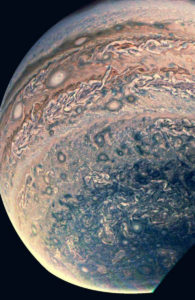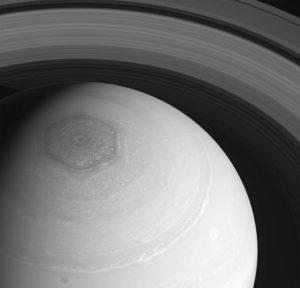Folks , the Juno probe has transformed our view about Jupiter & other gas giant planets :-
Juno Peers Deep into Jupiter's Abyss to Reveal Weird Winds
Breakthrough measurements of Jupiter’s hidden interior could revolutionize our understanding of giant planets
- By Lee Billings on March 7, 2018
This composite image from NASA's Juno spacecraft shows an unexplained cluster of cyclones around Jupiter's south pole. Taken in infrared wavelengths, the image also reveals heat radiating from deep within Jupiter: yellow indicates the presence of thinner clouds and dark red shows thicker ones. Credit: NASA, SWRI, JPL, ASI, INAF and IAPS
Jupiter’s beauty is more than skin deep.
That’s the latest result from Juno, a NASA spacecraft in orbit around the gas giant since 2016. Besides its Great Red Spot, Jupiter’s most eye-catching features are its alternating longitudinal bands of light and dark clouds. Thought to be as old as the planet itself, these bands are sculpted by high-speed winds whipping around the orb in opposite directions, and constitute the “face” Jupiter presents to the outside world. But what lies beneath? How far down do these wind bands go, and what connection do they have to the planet’s dense interior of hydrogen and helium?
If you had asked an expert over the past half century, you would have heard two general possibilities: Either the winds go as deep as 10,000 kilometers from the cloud tops and are driven by heat rising from those depths or they are very shallow and confined to just the top few hundred kilometers of Jupiter’s atmosphere. No one knew for sure—until now.
Advertisement
“The answer is neither,” says David Stevenson, a planetary scientist at the California Institute of Technology who leads the Juno team studying the planet’s interior. In a trio of papers published Wednesday in Nature , Stevenson and co-authors analyze new Juno measurements of Jupiter’s gravitational field to reveal a more nuanced situation: The winds extend downward about 3,000 kilometers (about one twentieth of the planet’s radius), and go no deeper. At that boundary, atmospheric pressures 100,000 times higher than those at Earth’s surface strip protons and electrons from the planet’s hydrogen. These charged particles drag against Jupiter’s powerful magnetic field, dampening the winds. Everything farther down acts like a solid body but remains fluid all the way to the planet’s mysterious core. “This matters,” Stevenson says, “because it helps us understand how the planet works.”
That could be crucial to learning much more: Jupiter was likely the first planet to form around the sun, so its inner workings—particularly the nature of its core and how heat trickles out from the planet’s abyssal depths—may offer hints about how other planets came to be, both in our solar system and around other stars. “People have been fighting about this since before I was born,” says Jonathan Fortney, a planetary scientist at the University of California, Santa Cruz, who wrote an accompanying commentary for the papers. “But there was no data set capable of answering this question until Juno.”
Setting an Interplanetary Speed Trap
To see beneath Jupiter’s veil of clouds and study its winds, the Juno team precisely measured the planet’s gravitational field. The fundamentals of the technique are simple: As Jupiter whirls around its axis, the resulting force should raise a slight, perfectly symmetric bulge around the planet’s equator. Any asymmetry would be an unmistakable sign of complex internal structures, such as large flows of material deep in the planet’s atmosphere. Juno carries no instrument capable of directly measuring such asymmetries, but they should manifest as subtle alterations in the spacecraft’s motion as it moves through its 53-day polar orbit around the planet.
Using a large antenna from NASA’s Deep Space Network of radio telescopes tuned in to a special transponder on Juno provided by the Italian Space Agency, the team repeatedly searched for any unexplained anomalies in the spacecraft’s trajectory. This technique is a bit like using a highway patrol radar gun, says Luciano Iess, a researcher at Sapienza University of Rome who led one analysis of the gathered data. The antenna beams radio waves from Earth, which Juno’s transponder receives and sends back. The change in frequency between the two transmissions is proportional to Juno’s speed with respect to Earth. “We used this radio link between Juno and Earth to measure the velocity of the spacecraft to exquisite accuracy—to 0.01 millimeter per second or better,” Iess says. “This is one hundredth the speed of a snail!” All discerned from some 750 million kilometers away.
After a painstaking analysis that modeled all known sources of acceleration for Juno, including the minute contributions from sunlight warming the spacecraft, Iess’s team found a large north-south asymmetry in Jupiter’s gravitational field—a clear sign of material flowing beneath the cloud tops on deep atmospheric winds. An independent analysis by William Folkner and colleagues at the NASA Jet Propulsion Laboratory verified the difficult measurement. Next, two additional teams (one led by Yohai Kaspi of the Weizmann Institute of Science in Israel, the other by Tristan Guillot of the Côte d'Azur Observatory in France) delved deeper into complementary subsets of the data. Both of these teams’ analyses converged on the figure of approximately 3,000 kilometers as the lower boundary for the flows.
Advertisement
A New Paradigm for Giant Planets
These results indicate these flows represent roughly 1 percent of Jupiter’s total mass, meaning Jupiter’s winds are continuously blowing more than three Earth masses of material around the planet. They also suggest the electrical conductivity of a gas-giant planet’s atmosphere is the crucial property that sets the limits for such a world’s dynamic winds, as ionized gases at high pressures drag against its magnetic field. Because a gas giant’s atmospheric pressure and magnetic field both depend on its mass, less-massive worlds such as Saturn should have dynamic weather extending more than three times deeper than Jupiter’s. Gas-giant planets more massive than Jupiter—as well as “failed stars” called brown dwarfs—should conversely have much shallower winds.
Remarkably, these predictions are already being tested. The Cassini orbiter, which ended its 13-year tour of the Saturn system last year by burning up in the planet’s atmosphere, also beamed back telemetry measuring that planet’s gravitational field. “We had the unique opportunity to compare the two planets at the same time,” says Iess, who has analyzed the Cassini data with Burkhard Militzer, a planetary scientist at the University of California, Berkeley. “We tried to fit the Cassini data in the same way as Juno’s data, but simply it did not work. The picture that is emerging from Cassini is that of a planet very different from Jupiter.” But according to rumor, Saturn is different in a very specific way—its dynamic weather appears to extend much deeper into the planet than Jupiter’s, just as predicted. The pair and their collaborators have reportedly submitted a paper detailing the findings to the journal Science .
There still is, of course, much still to do at Jupiter, and Juno’s time is running out. Its primary mission is slated to end this July. NASA might choose to extend it, but the spacecraft could still succumb any day to the intense radiation from the deadly halos of high-energy particles trapped around the planet by magnetic fields. Provided their spacecraft stays healthy and funded, the Juno team is contemplating additional measurements that could further probe Jupiter’s interior, such as monitoring tidal bulges raised by large moons whipping around the planet. Back on Earth at least one group of astronomers is using ground-based telescopes to search for seismic waves rippling through the atmospheres of Jupiter and Saturn, a phenomenon roughly analogous to earthquakes on our own world.

Sign up for Scientific American ’s free newsletters.
These and other upcoming studies could perhaps shed light on a newfound mystery, presented in a fourth paper published by members of the Juno team in Nature this week. It provides more details about previously reported cyclones clustered around the poles of both planets. These cyclones—which reside in bizarrely stable and geometric patterns that defy most model-based predictions—remain unexplained. And any linkage they may have to the planet’s deep dynamics is unknown. For now, Jupiter still has some secrets.








